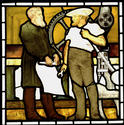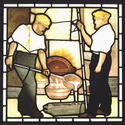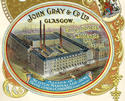Industry and Technology
By John R Hume
 The shifting local government boundaries of the city of Glasgow make coherent discussion difficult without definition. Here "Glasgow" will be taken to mean the area within the boundary as revised in 1912. This area was by then heavily industrialised, and had already undergone some dramatic structural changes. This essay looks at the city's more celebrated industries and refers briefly to some lesser-known but significant ones.
The shifting local government boundaries of the city of Glasgow make coherent discussion difficult without definition. Here "Glasgow" will be taken to mean the area within the boundary as revised in 1912. This area was by then heavily industrialised, and had already undergone some dramatic structural changes. This essay looks at the city's more celebrated industries and refers briefly to some lesser-known but significant ones.
Textiles
 In 1830 Glasgow was dominated by cotton textiles and related industries like bleaching, dyeing, chemicals and textile engineering. It had a sophisticated support system of collieries, brickworks and quarries, a good transport system of roads and canals and the beginnings of a railway network. Cotton spinning was the leading sector. There were many hand-loom weavers but power-looms were being introduced both in single-purpose factories and in integrated spinning and weaving concerns. After 1850 spinning declined in importance but power-loom weaving of fancy muslins and high-quality shirtings continued to expand up to the First World War. Other textile industries which developed included carpet weaving, cotton thread manufacture and linen and jute production. Textile finishing was also significant, both in the city and in suburban villages like Pollokshaws, Netherlee and Maryhill.
In 1830 Glasgow was dominated by cotton textiles and related industries like bleaching, dyeing, chemicals and textile engineering. It had a sophisticated support system of collieries, brickworks and quarries, a good transport system of roads and canals and the beginnings of a railway network. Cotton spinning was the leading sector. There were many hand-loom weavers but power-looms were being introduced both in single-purpose factories and in integrated spinning and weaving concerns. After 1850 spinning declined in importance but power-loom weaving of fancy muslins and high-quality shirtings continued to expand up to the First World War. Other textile industries which developed included carpet weaving, cotton thread manufacture and linen and jute production. Textile finishing was also significant, both in the city and in suburban villages like Pollokshaws, Netherlee and Maryhill.
Metal-working
 Metal-working was already important in 1830, with steam-engine manufacture, boiler making, iron and brass founding and the making of sugar and textile machinery already well-established. Its significance rapidly increased from the 1840s. It was engineering and iron shipbuilding that became the city's distinctive industries. Glasgow was the focus of the very important west of Scotland pig-iron industry, and eventually of the malleable-iron and steel trades. Cheap, good-quality iron and steel were vital to the success of the heavy metal-working trades which in turn influenced the techniques used in the iron and steel industries. The hot-blast process for iron-smelting produced fine foundry iron, encouraging the growth of ironfounding and hence of machinery manufacture.
Metal-working was already important in 1830, with steam-engine manufacture, boiler making, iron and brass founding and the making of sugar and textile machinery already well-established. Its significance rapidly increased from the 1840s. It was engineering and iron shipbuilding that became the city's distinctive industries. Glasgow was the focus of the very important west of Scotland pig-iron industry, and eventually of the malleable-iron and steel trades. Cheap, good-quality iron and steel were vital to the success of the heavy metal-working trades which in turn influenced the techniques used in the iron and steel industries. The hot-blast process for iron-smelting produced fine foundry iron, encouraging the growth of ironfounding and hence of machinery manufacture.
Shipbuilding and Marine Engineering
 Conversely, the demands of shipbuilding for a reliable quality of steel led to the dominance of the acid open-hearth process in Scottish steelmaking. Shipbuilding and marine engineering were Glasgow's most renowned industries for most of the period. Key figures and firms were David and Robert Napier, who did more than anyone else to establish safe and speedy steam navigation; Tod & MacGregor, who pioneered the construction of ocean-going iron steamships; John Elder and A C Kirk, who developed steam engines to make steamships competitive with sail on world trade routes, and James Howden and others who developed the Scotch marine boiler to supply steam for these engines. Glasgow naval architects were famous for designing iron and steel hulls for the largest and fastest merchant ships. It should be remembered that the city's shipyard workers were the most efficient in the world. Nor were local firms reluctant to adopt technologies developed elsewhere: steel for hulls, marine steam turbines, and diesel and other oil engines for vessels of all sizes. By 1914 Glasgow had the first works in the world specially constructed for building large marine diesel engines.
Conversely, the demands of shipbuilding for a reliable quality of steel led to the dominance of the acid open-hearth process in Scottish steelmaking. Shipbuilding and marine engineering were Glasgow's most renowned industries for most of the period. Key figures and firms were David and Robert Napier, who did more than anyone else to establish safe and speedy steam navigation; Tod & MacGregor, who pioneered the construction of ocean-going iron steamships; John Elder and A C Kirk, who developed steam engines to make steamships competitive with sail on world trade routes, and James Howden and others who developed the Scotch marine boiler to supply steam for these engines. Glasgow naval architects were famous for designing iron and steel hulls for the largest and fastest merchant ships. It should be remembered that the city's shipyard workers were the most efficient in the world. Nor were local firms reluctant to adopt technologies developed elsewhere: steel for hulls, marine steam turbines, and diesel and other oil engines for vessels of all sizes. By 1914 Glasgow had the first works in the world specially constructed for building large marine diesel engines.
Heavy Engineering
 Locomotive building was another notable Glasgow industry. The largest Scottish railway companies, the North British and the Caledonian, had their workshops in Glasgow. By 1900 there were three important independent locomotive builders who amalgamated in 1903 as the North British Locomotive Co Ltd, Europe's largest locomotive-builders. Among Glasgow's first-class locomotive designers were Dugald Drummond and J F McIntosh, noted both for efficiency and beauty in their designs.
Locomotive building was another notable Glasgow industry. The largest Scottish railway companies, the North British and the Caledonian, had their workshops in Glasgow. By 1900 there were three important independent locomotive builders who amalgamated in 1903 as the North British Locomotive Co Ltd, Europe's largest locomotive-builders. Among Glasgow's first-class locomotive designers were Dugald Drummond and J F McIntosh, noted both for efficiency and beauty in their designs.
 Other branches of engineering in which the city excelled included sugar machinery manufacture. Firms such as P & W McOnie, A & W Smith and Mirrlees Watson led the world for many years. Ironfounding was vital to the success of the mechanical engineering industries, but it also produced castings for many other purposes. Architectural castings were made on a vast scale by the Saracen and Sun foundries, and by now-forgotten companies like McDowall, Steven and Co, who exported extensively as did the cast-iron pipe founders, whose products introduced piped water into cities like Bombay and Buenos Ayres.
Other branches of engineering in which the city excelled included sugar machinery manufacture. Firms such as P & W McOnie, A & W Smith and Mirrlees Watson led the world for many years. Ironfounding was vital to the success of the mechanical engineering industries, but it also produced castings for many other purposes. Architectural castings were made on a vast scale by the Saracen and Sun foundries, and by now-forgotten companies like McDowall, Steven and Co, who exported extensively as did the cast-iron pipe founders, whose products introduced piped water into cities like Bombay and Buenos Ayres.
 Glasgow firms were particularly renowned for structural iron and steelwork. Sir William Arrol and Co built through their subsidiary Tancred, Arrol and Co the second Tay Bridge and the Forth Bridge, the largest structures of their kind in the world. They built many other bridges, and a large number of steel-framed engineering and shipbuilding workshops. Other firms like Arrol's Bridge and Roofing Co Ltd and P & W MacLellan also turned out large volumes of work, much of it for export. Smaller corrugated-iron clad buildings were made on a considerable scale by A & J Main and Frederick Braby & Co. Many were exported.
Glasgow firms were particularly renowned for structural iron and steelwork. Sir William Arrol and Co built through their subsidiary Tancred, Arrol and Co the second Tay Bridge and the Forth Bridge, the largest structures of their kind in the world. They built many other bridges, and a large number of steel-framed engineering and shipbuilding workshops. Other firms like Arrol's Bridge and Roofing Co Ltd and P & W MacLellan also turned out large volumes of work, much of it for export. Smaller corrugated-iron clad buildings were made on a considerable scale by A & J Main and Frederick Braby & Co. Many were exported.
 Another significant industry was the forging of heavy components for engineers and shipbuilders. The Lancefield and Parkhead forges were the most important, Parkhead developed steel making to replace malleable iron. Under William Beardmore, Parkhead became the centre of a very large business empire. Steel casting and the manufacture of heavy guns were introduced, but the prime business remained heavy forging.
Another significant industry was the forging of heavy components for engineers and shipbuilders. The Lancefield and Parkhead forges were the most important, Parkhead developed steel making to replace malleable iron. Under William Beardmore, Parkhead became the centre of a very large business empire. Steel casting and the manufacture of heavy guns were introduced, but the prime business remained heavy forging.
 It was through the metal-working trades that Glasgow played a major part in the opening up of world trade and indeed in shaping the 20th century world. In comparison the city's other significant industries inevitably suffer. Nonetheless as one of the world's greatest industrial cities Glasgow had a rich and diversified industrial structure.
It was through the metal-working trades that Glasgow played a major part in the opening up of world trade and indeed in shaping the 20th century world. In comparison the city's other significant industries inevitably suffer. Nonetheless as one of the world's greatest industrial cities Glasgow had a rich and diversified industrial structure.
Other Industries
 Many of its other industries served export markets, including whisky distilling and blending, brewing, biscuit baking, confectionery manufacture, book printing, pottery and clay tobacco-pipe manufacture and optical and other scientific instrument making. Others served the whole of west central Scotland, such as clothing manufacture, flour milling, bread baking, newspaper printing, tobacco manufacture, the bottling of aerated waters, tea blending, sawmilling, vehicle manufacture and papermaking. In smaller places any one of these industries conducted on the same scale would have been worth special attention. It is a measure of Glasgow's strength in depth that here they are the second division. This strength allowed Glasgow to contribute largely to the Allies' victory in the First World War. Afterwards, nothing would ever be the same.
Many of its other industries served export markets, including whisky distilling and blending, brewing, biscuit baking, confectionery manufacture, book printing, pottery and clay tobacco-pipe manufacture and optical and other scientific instrument making. Others served the whole of west central Scotland, such as clothing manufacture, flour milling, bread baking, newspaper printing, tobacco manufacture, the bottling of aerated waters, tea blending, sawmilling, vehicle manufacture and papermaking. In smaller places any one of these industries conducted on the same scale would have been worth special attention. It is a measure of Glasgow's strength in depth that here they are the second division. This strength allowed Glasgow to contribute largely to the Allies' victory in the First World War. Afterwards, nothing would ever be the same.